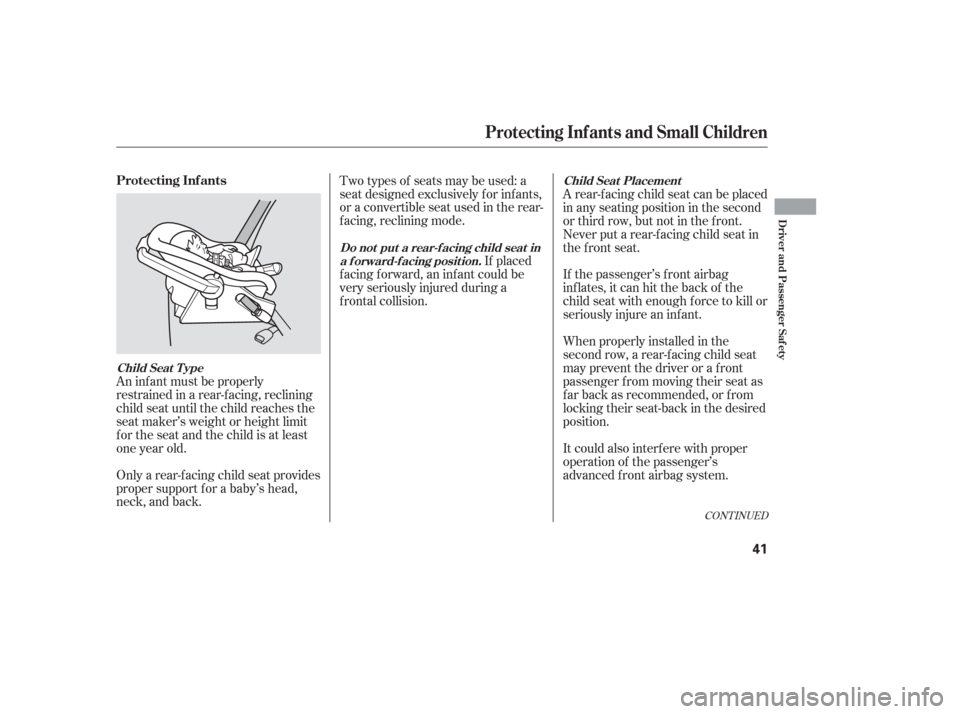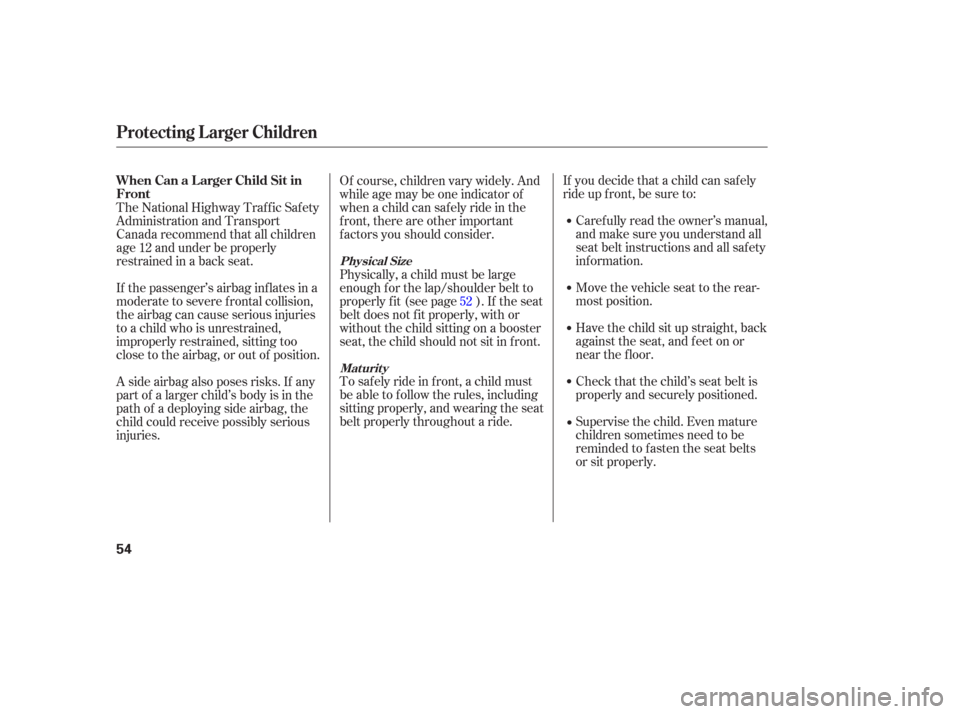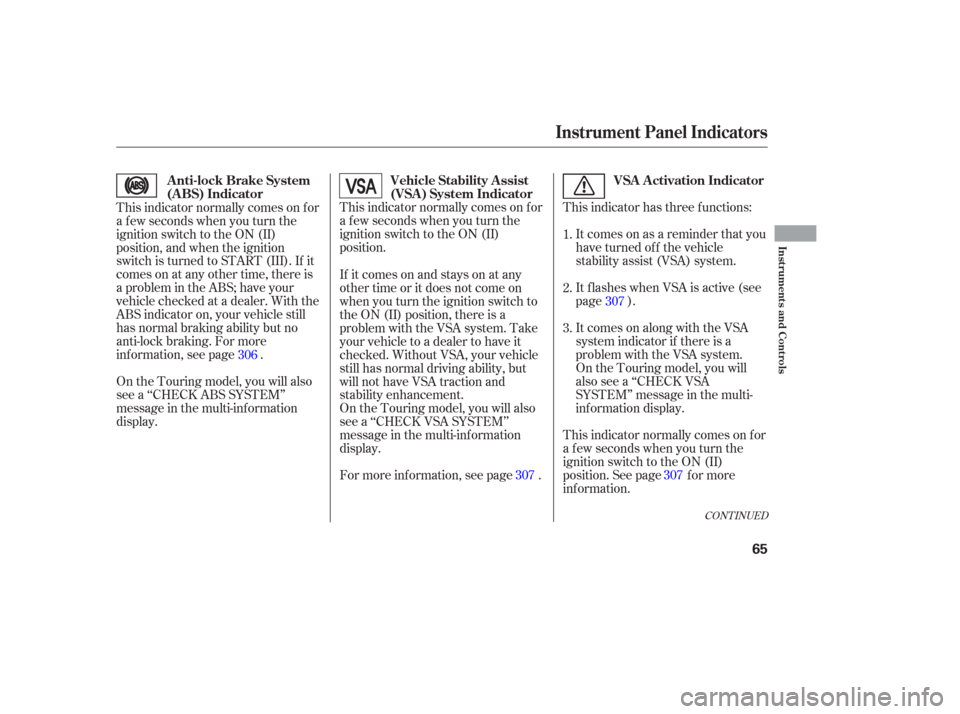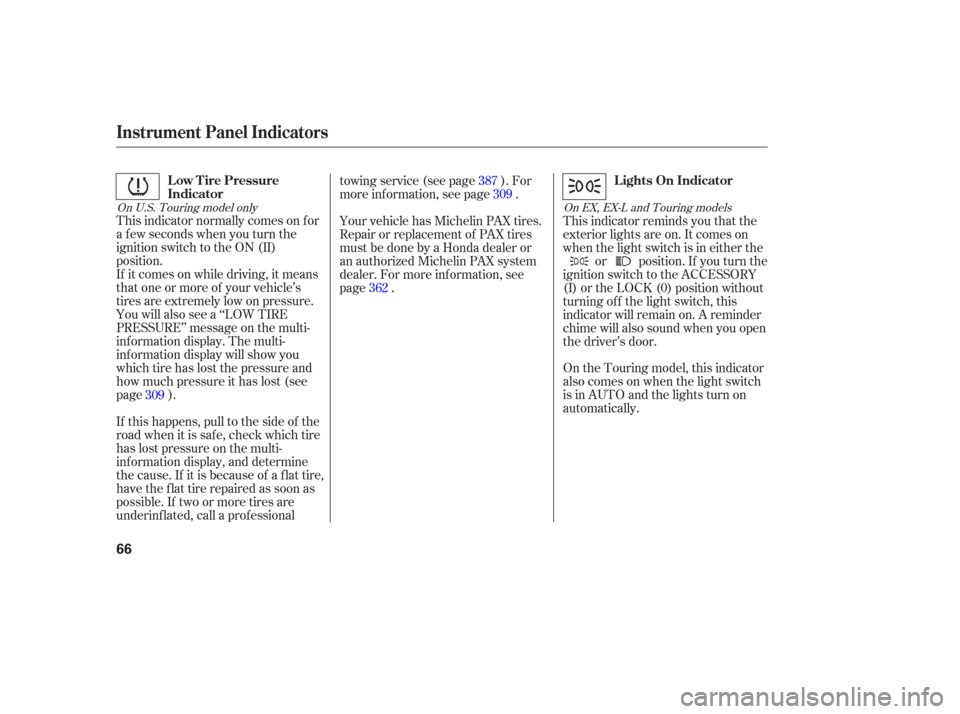Page 42 of 420

An inf ant must be properly
restrained in a rear-f acing, reclining
child seat until the child reaches the
seat maker’s weight or height limit
for the seat and the child is at least
one year old.
Only a rear-f acing child seat provides
proper support f or a baby’s head,
neck, and back.Two types of seats may be used: a
seat designed exclusively f or inf ants,
or a convertible seat used in the rear-
f acing, reclining mode.
If placed
f acing f orward, an inf ant could be
very seriously injured during a
f rontal collision. If the passenger’s front airbag
inflates, it can hit the back of the
child seat with enough f orce to kill or
seriously injure an inf ant. A rear-f acing child seat can be placed
in any seating position in the second
or third row, but not in the f ront.
Never put a rear-f acing child seat in
the front seat.
When properly installed in the
second row, a rear-f acing child seat
maypreventthedriverorafront
passenger f rom moving their seat as
f ar back as recommended, or f rom
locking their seat-back in the desired
position.
It could also interf ere with proper
operation of the passenger’s
advanced front airbag system.
CONT INUED
Protecting Inf ants
Child Seat T ype Child Seat Placement
Do not put a rear-f acing child seat in a f orward-f acing position.
Protecting Inf ants and Small Children
Driver and Passenger Saf ety
41
Page 55 of 420

If you decide that a child can saf ely
ride up f ront, be sure to:Caref ully read the owner’s manual,
and make sure you understand all
seat belt instructions and all saf ety
inf ormation.
Move the vehicle seat to the rear-
most position.
Have the child sit up straight, back
against the seat, and feet on or
near the f loor.
Check that the child’s seat belt is
properly and securely positioned.
Supervise the child. Even mature
children sometimes need to be
reminded to f asten the seat belts
or sit properly.
To saf ely ride in f ront, a child must
be able to f ollow the rules, including
sitting properly, and wearing the seat
belt properly throughout a ride. Of course, children vary widely. And
while age may be one indicator of
when a child can saf ely ride in the
f ront, there are other important
f actors you should consider.
Physically, a child must be large
enough f or the lap/shoulder belt to
properly f it (see page ). If the seat
belt does not f it properly, with or
without the child sitting on a booster
seat, the child should not sit in f ront.
The National Highway Traffic Safety
Administration and Transport
Canada recommend that all children
age 12 and under be properly
restrained in a back seat.
If the passenger’s airbag inf lates in a
moderate to severe f rontal collision,
the airbag can cause serious injuries
to a child who is unrestrained,
improperly restrained, sitting too
close to the airbag, or out of position.
A side airbag also poses risks. If any
part of a larger child’s body is in the
path of a deploying side airbag, the
child could receive possibly serious
injuries. 52
Protecting L arger Children
Maturity
Physical Size
When Can a L arger Child Sit in
Front
54
Page 58 of 420
These labels are in the locations
shown. They warn you of potential
hazards that could cause serious
injury. Read these labels caref ully.
If a label comes of f or becomes hard
to read (except for the U.S.
dashboard label, which is removed
by the owner), contact your dealer
f or a replacement.
CONT INUED
U.S. models only
Saf ety L abels
Driver and Passenger Saf ety
57
RADIATOR CAP
HOOD DASHBOARD
Page 62 of 420
�Î
�Î�Î
The U.S. instrument panel is shown. Dif f erences f or the Canadian models are noted in the text.
Instrument Panel
Inst rument s and Cont rols
61
SUPPLEMENTAL
RESTRAINT SYSTEM
INDICATOR
HIGH BEAM
INDICATOR
LOW OIL PRESSURE
INDICATOR
IMMOBILIZER
SYSTEM
INDICATOR
POWER SLIDING
DOOR INDICATOR
ANTI-LOCK BRAKE
SYSTEM INDICATOR
LOW FUEL
INDICATOR
DOOR AND
TAILGATE OPEN
INDICATOR
PARKING BRAKE AND
BRAKE SYSTEM
INDICATOR SEAT BELT
REMINDER
INDICATOR
CHARGING
SYSTEM
INDICATOR
CRUISE CONTROL
MAIN INDICATOR
CRUISE CONTROL
INDICATOR
LIGHTS-ON INDICATOR
SIDE AIRBAG OFF
INDICATOR
VSA ACTIVATION
INDICATOR
VEHICLE STABILITY ASSIST
SYSTEM INDICATOR
FUEL ECONOMY
INDICATOR
MALFUNCTION
INDICATOR
LAMP (P.67)
(P.67)
(P.66) (P.70)
(P.63)
(P.70) (P.63)
(P.64)
(P.69)
(P.63)
(P.64)(P.64)(P.67) (P.68)(P.69) (P.69)
(P.65)
(P.65)
(P.65)
MAINTENANCE
MINDER
INDICATOR
(LX, EX and EX-L models)
(P.378)
Page 63 of 420
�Î
�Î�Î
The U.S. instrument panel is shown. Dif f erences f or the Canadian models are noted in the text.
Instrument Panel
62
SEAT BELT REMINDER
INDICATORCRUISE CONTROL
INDICATOR LOW TIRE PRESSURE
INDICATOR
FOG LIGHT
INDICATOR CHARGING SYSTEM
INDICATOR
SUPPLEMENTAL
RESTRAINT SYSTEM
INDICATORCRUISE CONTROL
MAIN INDICATOR
PARKING BRAKE AND
BRAKE SYSTEM
INDICATOR
IMMOBILIZER
SYSTEM
INDICATOR
LIGHTS-ON
INDICATOR
LOW OIL
PRESSURE
INDICATOR HIGH BEAM
INDICATOR LOW FUEL
INDICATOR
DOOR AND TAILGATE
OPEN INDICATOR
VSA
ACTIVATION
INDICATOR
(Touring models)
FUEL ECONOMY
INDICATOR VEHICLE STABILITY
ASSIST SYSTEM
INDICATOR
ANTI-LOCK BRAKE
SYSTEM INDICATOR
SIDE AIRBAG OFF
INDICATOR
MALFUNCTION
INDICATOR LAMP
SYSTEM
MESSAGE
INDICATOR
(P.66)
(P.63)
(P.69)
(P.70)
(P.63)(P.70)
(P.69)
(P.64) (P.64)(P.64)
(P.63) (P.68)
(P.67)
(P.65) (P.65)
(P.69)
(P.66)
(P.69)
(P.65)
(P.67)
(P.378)
Page 66 of 420

CONT INUED
This indicator has three f unctions:It comes on as a reminder that you
have turned off the vehicle
stability assist (VSA) system.
It flashes when VSA is active (see
page ).
On the Touring model, you will
also see a ‘‘CHECK VSA
SYSTEM’’ message in the multi-
inf ormation display.
This indicator normally comes on f or
a f ew seconds when you turn the
ignition switch to the ON (II)
position.
This indicator normally comes on f or
a f ew seconds when you turn the
ignition switch to the ON (II)
position. See page f or more
inf ormation.It comes on along with the VSA
system indicator if there is a
problem with the VSA system.
This indicator normally comes on f or
a f ew seconds when you turn the
ignition switch to the ON (II)
position, and when the ignition
switch is turned to START (III). If it
comes on at any other time, there is
a problem in the ABS; have your
vehicle checked at a dealer. With the
ABS indicator on, your vehicle still
has normal braking ability but no
anti-lock braking. For more
inf ormation, see page .
On the Touring model, you will also
see a ‘‘CHECK ABS SYSTEM’’
message in the multi-inf ormation
display. If itcomesonandstaysonatany
other time or it does not come on
when you turn the ignition switch to
the ON (II) position, there is a
problem with the VSA system. Take
your vehicle to a dealer to have it
checked. Without VSA, your vehicle
still has normal driving ability, but
will not have VSA traction and
stability enhancement.
On the Touring model, you will also
see a ‘‘CHECK VSA SYSTEM’’
message in the multi-inf ormation
display.
For more inf ormation, see page .1.
2.
3.
306 307
307
307
Instrument Panel Indicators
Vehicle Stability Assist
(VSA ) System Indicator VSA A ctivation Indicator
Anti-lock Brake System
(A BS) Indicator
Inst rument s and Cont rols
65
Page 67 of 420

This indicator normally comes on f or
a f ew seconds when you turn the
ignition switch to the ON (II)
position.
If it comes on while driving, it means
that one or more of your vehicle’s
tires are extremely low on pressure.
You will also see a ‘‘LOW TIRE
PRESSURE’’ message on the multi-
inf ormation display. The multi-
inf ormation display will show you
which tire has lost the pressure and
how much pressure it has lost (see
page ).This indicator reminds you that the
exterior lights are on. It comes on
when the light switch is in either the
or position. If you turn the
ignition switch to the ACCESSORY
(I) or the LOCK (0) position without
turning of f the light switch, this
indicator will remain on. A reminder
chime will also sound when you open
the driver’s door.
On the Touring model, this indicator
also comes on when the light switch
is in AUTO and the lights turn on
automatically.
If this happens, pull to the side of the
road when it is saf e, check which tire
has lost pressure on the multi-
inf ormation display, and determine
the cause. If it is because of a flat tire,
have the flat tire repaired as soon as
possible. If two or more tires are
underinf lated, call a prof essional towingservice(seepage ).For
more information, see page .
Your vehicle has Michelin PAX tires.
Repair or replacement of PAX tires
must be done by a Honda dealer or
an authorized Michelin PAX system
dealer. For more inf ormation, see
page .
309 387
362 309
On U.S. Touring model only
On EX, EX-L and Touring models
Instrument Panel Indicators
Low Tire Pressure
IndicatorLights On Indicator
66
Page 68 of 420

This indicator comes on f or a f ew
seconds when you turn the ignition
switch to the ON (II) position. It will
gooffifyouhaveinserteda
properly-coded ignition key. If it is
not a properly-coded key, the
indicator will blink and the engine
will not start (see page ).
This indicator also blinks several
times when you turn the ignition
switch f rom the ON (II) position to
the ACCESSORY (I) or the LOCK
(0) position.The appropriate light comes on in
this display if the tailgate or any door
is not closed tightly.
All the lights in the monitor come on
f or a f ew seconds when you turn the
ignition switch to the ON (II)
position.
On the Touring model, you will also
see a ‘‘CHECK LEFT SLIDING
DOOR’’ or ‘‘CHECK RIGHT
SLIDING DOOR’’ message in the
multi-inf ormation display. This indicator comes on f or a f ew
seconds when you turn the ignition
switch to the ON (II) position. If it
comes on at any other time, there is
a problem in the power sliding door
system. With this indicator on, move
themainswitchonthedashboardto
the OFF position, and have the
system checked by your dealer as
soon as possible. You can still open
or close each sliding door manually.
For more inf ormation on the power
sliding doors, see page .
133
146
On EX and EX-L models only
Instrument Panel Indicators
Immobilizer System
Indicator Door and T ailgate Open Monitor
Power Sliding
Door Indicator
Inst rument s and Cont rols
67
U.S. Canada